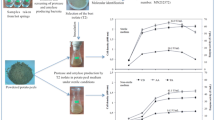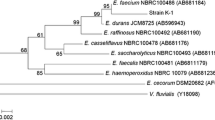Abstract
Rhizopus microsporus var. rhizopodiformis produced high levels of α-amylase and glucoamylase under solid state fermentation, with several agricultural residues, such as wheat bran, cassava flour, sugar cane bagasse, rice straw, corncob and crushed corncob as carbon sources. These materials were humidified with distilled water, tap water, or saline solutions—Segato Rizzatti (SR), Khanna or Vogel. The best substrate for amylase production was wheat bran with SR saline solution (1:2 v/v). Amylolytic activity was still improved (14.3%) with a mixture of wheat bran, corncob, starch and SR saline solution (1:1:0.3:4.6 w/w/w/v). The optimized culture conditions were initial pH 5, at 45 °C during 6 days and relative humidity around 76%. The crude extract exhibited temperature and pH optima around 65 °C and 4–5, respectively. Amylase activity was fully stable for 1 h at temperatures up to 75 °C, and at pH values between 2.5 and 7.5.



Similar content being viewed by others
References
Gupta R, Gigras P, Mohapatra H, Goswami VK, Chauhan B (2004) Microbial α-amylases: a biotecnological perspective. Process Biochem 38:1599–1616
Crabb WD, Mitchinson C (1997) Enzymes involved in the processing of starch to sugars. Trends Biotechnol 15:349–352
Chen J, Li D, Zhang Y, Zhou Q (2005) Purification and characterization of thermostable glucoamylase from Chaetomium thermophilum. J Gen Appl Microbiol 175–181
Aquino ACMM, Jorge JA, Terenzi HF, Polizeli MLTM (2003) Studies on a thermostable α-amylase from the thermophilic fungus Scytalidium thermophilum. Appl Microbiol Biotechnol 61(4):323–328
Cereia M, Terenzi HF, Jorge JA, Greene LJ, Rosa JC, Polizeli MLTM (2000) Glucoamylase activity from the thermophilic fungus Scytalidium thermophilum. Biochemical and regulatory properties. J Basic Microbiol 40(2):65–74
Kunamneni A, Permaul K, Singh S (2005) Amylase production in solid state fermentation by the thermophilic fungus Thermomyces lanuginosus. J Biosci Bioeng 100(2):168–171
Khrishna C (2005) Solid-state fermentation systems-an overview. Crit Rev Biotechnol 25(1–2):1–30
Bellon-Maurel V, Orliac O, Christen P (2003) Sensors and measurements in solid state fermentation: a review. Process Biochem 38:881–896
Rahardjo YSP, Sie S, Weber FJ, Tramper J, Rinzema A (2005) Effect of low oxygen concentrations on growth α-amylase production of Aspergillus oryzae in model solid-state fermentation systems. Biomol Eng 21:163–172
Han J (2002) Solid-state fermentation of cornmeal with the basidiomicete Hericium erinaceum for degrading starch and upgrading nutritional value. Int J Food Microbiol 80:61–66
Sandrim VC, Rizzatti ACS, Terenzi HF, Jorge JA, Milagres AMF, Polizeli MLTM (2005) Purification and biochemical characterization of two xylanases produced by Aspergillus caespitosus and their potential of kraft pulp bleaching. Process Biochem 40(5):1823–1828
Ray RC (2004) Extracellular amylase(s) production by fungi Botryodiplodia theobromae and Rhizopus oryzae grown on cassava starch residue. J Environ Biol 25(4):489–495
Schipper MAA, Stalpers JAA (1984) Revision of the genus Rhizopus. Stud Mycol 25:20–34
Peixoto SC, Jorge JA, Terenzi HF, Polizeli MLTM (2003) Rhizopus microsporus var. rhizopodiformis: a thermotolerant fungus with potential for production of thermostable amylases. Int Microbiol 6:269–273
Haidle CW, Strock R (1966) Localization of trehalose in the ascospores of Neurospora: Reaction to ascospores dormancy and germination. J Bacteriol 115:592–599
Miller GL (1959) Use of dinitrosalicylic acid reagent for determination of reducing sugar. Anal Chem 31:426–428
Bergmeyer HU, Bernt E (1974) Methods of enzymatic analysis—a textbook 1st edn. Worth Publishers, New York
Fuwa H (1954) A new method for microdetermination of amylase activity by the use of amylose as the substrate. J Biochem 41(5):583–603
Hagihara B, Matsubara H, Nakai M, Okunuki K (1958) Crystalline bacterial proteinase. J Biochem 45:185–194
Lowry OH, Rosebrough NJ, Farr AL, Randall RJ (1951) Protein measurement with the Folin phenol reagent. J Biol Chem 193:265–275
Khanna P, Sundari SS, Kumar NJ (1995) Production, isolation and partial purification of xylanase from Aspergillus sp. World J Microbiol Biotechnol 11:242–243
Vogel HF (1964) Distribution of lysine pathways among fungi: evolutionary implications. Am Nat 98:435–446
Rizzatti ACS, Jorge JA, Terenzi HF, Rechia CGV, Polizeli MLTM (2001) Purification and properties of a thermostable extracellular β-d-xylosidase produced by a thermotolerant Aspergillus phoenicis. J Ind Microbiol Biotechnol 26(3):156–160
Soccol CR, Marin B, Raimbault M, Lebault JM (1994) Breeding and growth of Rhizopus in cassava by solid state fermentation. Appl Microbiol Biotechnol 41:330–336
Sparringa RA, Kendall M, Westby A, Owens JD (2002) Effects of temperature, pH water activity and CO2 concentration on growth of Rhizopus oligosporus NRRL 2710. J Appl Microbiol 92:329–337
Wanderley KJ, Torres FAG, Moraes LMP, Ulhoa CJ (2004) Biochemical characterization of α-amylase from the yeast Cryptococcus flavus. Microbiol Lett 231:165–169
Ellaiah P, Adrnarayana K, Bhavani Y, Padmaja P, Srinivasulu B (2002) Optimization of process parameters for glucoamylase production under solid state fermentation by newly isolated Aspergillus species. Process Biochem 38:615–620
Shigechi H, Uyama K, Fujita Y, Matsumoto T, Ueda M, Tanaka A, Fukuda H, Kondo A (2002) Efficient ethanol production from starch through development of novel flocculent yeast strains displaying glucoamylase and co-displaying or secreting α-amylase. J Molec Catal 17:179–187
Kozlowski R, Batog J, Konczewicz W, Mackiewicz-Talarczyk M, Muzyczek M, Sedelnick N, Tanska B (2006) Enzymes in bast fibrous plant processing. Biotechnol Lett 28(10):761–765
Bhaskar N, Benila T, Radha C, Lalitha RG (2007) Partial purification and characterization of protease of Bacillus proteolyticus CFR3001 isolated from fish processing waste and its antibacterial activities. Bioresour Technol 98(14):2758–2764
Acknowledgments
This work was supported by grants from Fundação de Amparo à Pesquisa do Estado de São Paulo (FAPESP) and Conselho de Desenvolvimento Científico e Tecnológico (CNPq). H.F.T.; J.A.J.; M.L.T.M.P. are Research Fellows of CNPq. S.C.P.N. was Master recipient CAPES and this work is part of her Master Dissertation. We thank Ricardo F. Alarcon and Maurício de Oliveira for technical assistance.
Author information
Authors and Affiliations
Corresponding author
Rights and permissions
About this article
Cite this article
Peixoto-Nogueira, S.C., Sandrim, V.C., Guimarães, L.H.S. et al. Evidence of thermostable amylolytic activity from Rhizopus microsporus var. rhizopodiformis using wheat bran and corncob as alternative carbon source. Bioprocess Biosyst Eng 31, 329–334 (2008). https://doi.org/10.1007/s00449-007-0166-4
Received:
Accepted:
Published:
Issue Date:
DOI: https://doi.org/10.1007/s00449-007-0166-4




